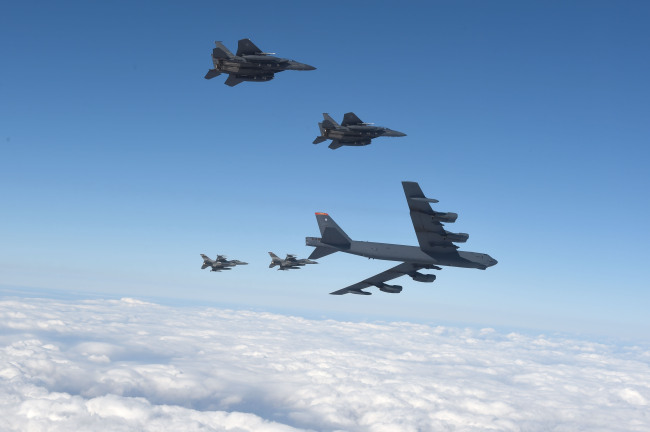The U.S. deployed its strategic nuclear-capable B-52 bomber to South Korea in a show of force against North Korea on Sunday, four days after the communist state claimed to have conducted a hydrogen bomb test.
The deployment was part of the allies’ coordinated military steps to respond to Pyongyang’s latest provocation. As a first step, Seoul resumed its loudspeaker propaganda broadcasts along the heavily fortified border last Friday.
The B-52 bomber, which is a core element of the U.S.’ strategic nuclear force, took off from Andersen Air Force base in Guam early in the morning and reached the U.S. Osan Air Base in Pyeongtaek, Gyeonggi Province, at around noon, the U.S. Forces Korea told the media.
Escorted by two South Korean F-15K fighters and two U.S. F-16 fighters, the long-range bomber staged a low-altitude flight over the Osan Air Base and then returned to Guam.
Upon the bomber’s arrival, South Korea’s Air Force Operations commander Lt. Gen. Lee Wang-keun and U.S. Seventh Air Force commander Lt. Gen. Terrence O’Shaughnessy issued separate statements in which they underscored the allies’ resolve to maintain a robust deterrence and fend off Pyongyang’s potential provocations.
“The United States remains steadfast in its commitment to the defense of the Republic of Korea and to maintaining stability on the Korean Peninsula, to include extended deterrence provided by our conventional forces and our nuclear umbrella,” O’Shaughnessy said in a statement.
“As demonstrated by today’s mission, the combined U.S. and Republic of Korea air forces work and train together closely every day, and we are prepared to meet any threat to our alliance, or the great nation of the Republic of Korea,” he added.
Extended deterrence refers to Washington’s stated commitment to deterring military threats to its key Asian ally of the South, including those from the North’s nuclear weapons and other weapons of mass destruction.
Lee also stressed that the allies are fully ready to retaliate if provoked.
“Our Air Force is ready to sternly and strongly retaliate should Pyongyang set off provocations no matter where and when it provokes,” Lee said in his statement. “Based on the allied combined air power, close cooperation on intelligence sharing and our strong and meticulous firepower, we will neutralize the enemy’s will to launch provocations.”
The B-52, whose maximum operational range is 16,000 kilometers, measures 48 meters in length, 56.4 meters in width and 221.35 tons in weight. It can conduct independent wartime operations in areas some 6,400 km away from its home base, with 31 tons of bombs including “GBU-57” bunker busters that could destroy the North’s underground wartime command facilities.
The B-52’s flight over the peninsula came as the allies are in talks over the deployment of U.S. strategic military assets in response to the North’s nuclear experiment.
The U.S. is reportedly considering deploying a nuclear-powered aircraft carrier, possibly the 104,000-ton USS Ronald Reagan, next month. The 333-meter-long carrier, currently based in Yokosuka, Japan, carries some 80 aircraft and some 5,400 crewmembers.
Other strategic assets the U.S. could also deploy to the South include a B-2 stealth bomber, an Ohio-class 18,000-ton nuclear-powered submarine; and an F-22 radar-evading fighter -- stationed in Okinawa -- Japan, among others.
Earlier in the day, the North’s official Korean Central News Agency reported that North Korean leader Kim Jong-un defended the country’s latest nuclear test as a “self-defense” measure to protect itself against threats of a nuclear war by the “U.S. and imperialists.”
Kim made the remarks during his visit to the North’s Ministry of People’s Armed Forces, which is equivalent to the South’s Defense Ministry.
“At the dawn of the New Year when the seventh national congress of the Workers’ Party is to be held (in May), the hydrogen bomb test was conducted as a self-defense step to thoroughly safeguard the country’s autonomy, its right to life and peace on the peninsula and in the region,” he was quoted by the KCNA as saying.
“It is a legitimate right of a sovereign nation, which no one can dispute.”
He was accompanied by Hwang Pyong-so, the director of the North Korean military’s General Political Bureau, Park Yong-sik, head of the Ministry of the People’s Armed Forces and Ri Yong-gil, chief of the General Staff of the military.
Meanwhile, Seoul continued its propaganda broadcasts in some 10 areas around the tense border over the weekend, although a senior official of the North’s ruling party warned last Friday that the broadcasts are bringing the current situation to the “brink of war.”
Seoul’s military authorities said the North stepped up its vigilance posture along the border by increasing its artillery assets at its frontline units close to South Korea’s loudspeakers.
The North has called the broadcasts a “threat to its (communist) system,” as the broadcasts highlight South Korea’s economic advancement, the benefits of liberal democracy, the importance of human rights and call for the restoration of the divided nation’s homogeneity, among other things.
Along with the military efforts, Seoul has stepped up its diplomacy to secure global cooperation to address the North’s nuclear threats.
Seoul is slated to hold vice-ministerial-level talks with Washington and Tokyo in the Japanese capital this week to discuss trilateral cooperation over the North’s latest atomic test. The three nations are also expected to discuss ways to secure China’s cooperation in holding the North responsible for the nuclear provocation.
Seoul’s Vice Foreign Minister Lim Sung-nam, Washington’s Deputy Secretary of State Tony Blinken and Tokyo’s Vice Foreign Minister Akitaka Saik are to attend the meeting.
Before the vice-ministerial talks, the three nations’ chief nuclear negotiators are also expected to meet in Seoul.
By Song Sang-ho (
sshluck@heraldcorp.com)








![[Today’s K-pop] Blackpink’s Jennie, Lisa invited to Coachella as solo acts](http://res.heraldm.com/phpwas/restmb_idxmake.php?idx=644&simg=/content/image/2024/11/21/20241121050099_0.jpg)